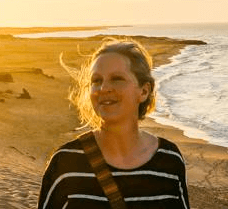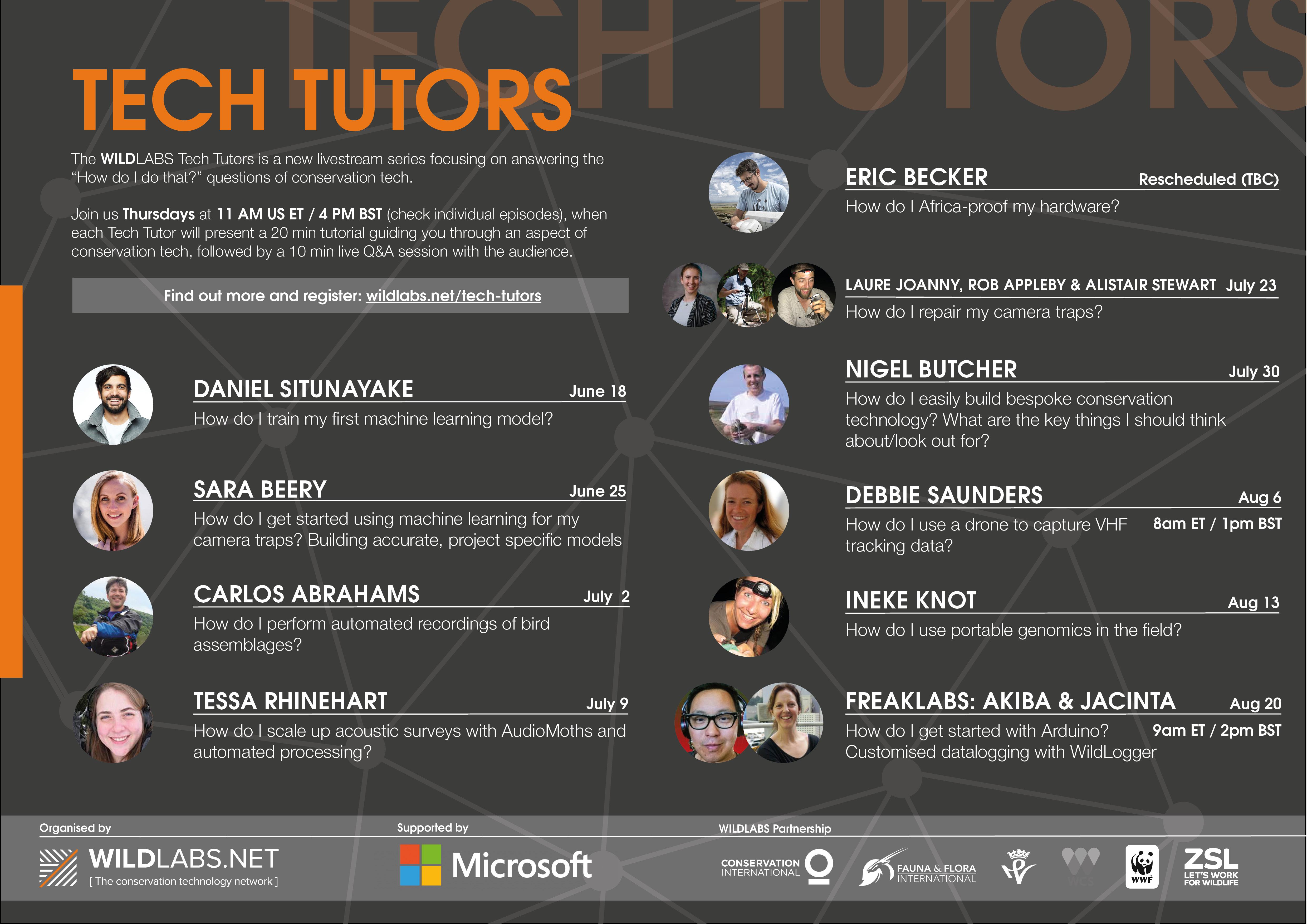About the Series
Introducing the WILDLABS Tech Tutors, our new series that focuses on answering the "how do I do that?" questions of conservation tech. Launched with the support of Microsoft AI for Earth, this series will give you the bite-sized, easy-to-understand building blocks you'll need to try new conservation technology, enhance your research, or DIY a project for the first time.
Taking place every Thursday, each Tech Tutor will present a 20 minute tutorial guiding you through an aspect of conservation tech, followed by a 10 minute live Q&A session with the audience.
For participants, the outcome will be an increased sense of confidence in their technological skills, the ability to actively build off of the skills discussed in these tutorials, and an opportunity to learn and collaborate with other members of the WILDLABS community. Our goal is to customize these tutorials to fit the needs of the community and address your needs, so let us know what you want to see in this season and beyond.
Can't make it? You can find every tutorial after it airs on our Youtube channel.
Catch up on the chat and shared resources from the session in our collaborative notes here.
Meet Your Tutors: Akiba and Jacinta, Freaklabs
Chris ‘Akiba’ Wang
Akiba has a background in electronics and product design and has been designing circuits for the past 25 years. He’s taught for MIT Media Lab and has been a researcher there as well as Keio University and Osaka University in Japan. His specialty is in wireless sensor networks and worked on the Zigbee standard as well as other communications standards. His work has gravitated towards technology for environmental monitoring and is now working on wildlife conservation.
Jacinta Plucinski
Jacinta is a developer specializing in web technologies using python and javascript. She’s also a published author, runs her own book publishing company, and has started her own magazine. She’s a co-founder of Tokyo Hackerspace and Hackerfarm, and when not working on technology or publishing projects, she experiments with regenerative and sustainable agriculture.
About Freaklabs
Freaklabs develops environmental monitoring technology in partnership with individual researchers, conservation organisations, NGOs and governments. We’ve worked with The World Bank, International Rice Research Institute and UNESCO.
Our projects include adding audio triggers to camera traps in the Serengeti to monitor predator/prey responses, monitoring the GPS and liquid levels in sanitation trucks in Egypt to prevent illegal dumping into the Nile, monitoring water levels in rice paddy fields in Philippines for more sustainable water management, and radiation monitoring in Japan.
We also started Tokyo Hackerspace and Hackerfarm in Japan where we experiment with organic and regenerative agriculture and technology.
Connect with Freaklabs on WILDLABS, on Twitter, and on their website: www.freaklabs.org/conservation (live soon!)
We asked Akiba and Jacinta...
What will I learn to do in this tutorial?
This is the first tutorial in a series on creating a deployment-ready, customised data logger, using the Arduino-based WildLogger. With WildLogger, the series will go through the process of developing custom hardware that uses or adapts existing arduino-based boards, modules and software, for wildlife and conservation research.
Once you understand the process of how a custom device is developed, you can tap into a whole range of accessible and affordable hardware to create instrumentation tailored to your needs and environment.
The series will cover:
- Definition & Specs: Translating what you want into hardware, software and mechanical specifications
- Decisions: Choosing appropriate sensors, enclosures, connectors, cables and batteries for your design goals and deployment environment
- Design Stack: Understanding hardware and the full application stack (components, drivers, libraries and applications)
- Setup: Setting up the application development environment
- Programming: Writing the application (what software already exists, what do you need to write)
- Optimizing: Optimising the device for power and reliability
- Assembly: Building the devices (including crimping cables, modifying enclosures, testing)
- Pilot: Doing controlled test deployments to make sure they work before they go into the field
- Troubleshooting: Debugging in the field (including ‘must have’ equipment in your field kits)
In the first session, we’ll be discussing the Arduino platform, its advantages and disadvantages, and brainstorm its possibilities in wildlife research and conservation.
We’ll also discuss in more detail the topics covered in the rest of the series.
How can I learn more about this subject?
Whilst more accessible, creating your own hardware still requires a broad skill-set. There’s a lot of information on the internet about Arduino, but it’s difficult to sift through since it’s of varying technical detail, relevance, and quality.
This tutorial series aims to get you started, so we recommend starting there :)
Afterwards, you will have enough of an understanding to either search more specifically or ask more precise questions on how to implement what you want to do.
There’s also an interesting article of other researchers joining with engineers to create their own instrumentation here.
If I want to take the next step using this technology, where should I start?
Define your need or problem, even if it’s very simple. Then define the functionality, and the context or environment you’ll be deploying the hardware in.
Research if there’s existing devices, what their parameters are, and what kinds of modifications you might need to make. Then reach out to people for advice on how to implement it. This could be on the WILDLABS forum or us :)
What advice do you have for a complete beginner in this subject?
Hold on to your hats because almost anything is possible. Hardware has never been more customisable, accessible and affordable. It will take some time to learn, but it’s worth it.
It’s likely you have skills you can bring across already, such as programming experience, knowledge of sensors or enclosures that you want to use, and so on.
For things you don’t know, don’t be afraid to ask questions or post on the forums. Some of the terminology might be intimidating or you might feel like you should know things that you don’t but it’s important to get beyond that.
Most people, ourselves included, enjoy answering questions and are even more curious if there’s a cool application being concocted. In our experience, most engineers are looking for problems to solve and questions to answer. So feel free to throw all your questions at the engineers and see what comes back!
Learn more about our Tech Tutorials
Visit the series page on WILDLABS to find the full list of WILDLABS Tech Tutors.




Add the first post in this thread.